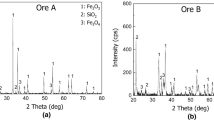Abstract
The increase of the proportion of high Al2O3 content iron ore fine in iron and steel enterprises has brought about a series of problems such as the increase of the viscosity of blast furnace slag and the difficulty of the separation of slag and iron. In order to solve this problem, the effect of increasing MgO content on the technical and economic index, the cold strength, and metallurgical properties of high basicity and high-alumina sinter was studied through sinter pot test. Nova400NanoSEM field emission scanning electron microscope was used to analyze sinter microstructure. The experimental results show that when the MgO content fraction in the sinter with high basicity and high aluminum increases from 1.72 to 2.49%, the vertical sintering speed decreases by 4.38mm/min, the utilization coefficient decreases by 0.51t/(m2 h), and the low-temperature reduction degradation index increases by 6.7%. When MgO content in sinter is 2.11%, drum index and reducibility index are the highest, reaching 61.93% and 86.39% respectively. Mg2+ is mainly solid dissolved in the magnetite lattice and replaces Fe2+, up to 3.64%. The generated magnesie-containing magnetite inhibits the phase transition from Fe3O4 to Fe2O3 oxidation process in the sinter cooling process, which reduces the generation of secondary hematite and is conducive to improving the low-temperature reduction degradation performance of sinter.







Similar content being viewed by others
References
Choudhary KM, Bhattachajee D, Bannerjee PS, Lahiri AK (2008) Effect of variation of alumina on development of phases during iron ore sintering. ISIJ Int 48:1804–1806. https://doi.org/10.2355/isijinternational.48.1804
Lu L, Holmers RJ, Manuel JR (2007) Effects of alumina on sintering performance of hematite iron ores. ISIJ Int 47:349–358. https://doi.org/10.2355/isijinternational.47.349
Umadevi, Nelson, Mahapatra, Prabhu, Ranjan (2009) Influence of magnesia on iron ore sinter properties and productivity. Ironmak Steelmak 36(7):515–520. https://doi.org/10.1179/174328109X445741
Zhou M, Yang ST, Jiang T, Xue XX (2015) Influence of MgO in form of magnesite on properties and mineralogy of high chromium, vanadium, titanium magnetite sinters. Ironmak Steelmak 42:320–327. https://doi.org/10.1179/1743281214y.0000000223
Umadevi T, Nelson K, Mahapatra PC, Prabhu M, Ranjan M (2010) Influence of magnesia on iron ore sinter properties and productivity. Ironmak Steelmak 36:515–522. https://doi.org/10.1179/174328109X445741
Shen F, Jiang X, Wu G (2006) Proper MgO addition in blast furnace operation. ISIJ Int 46:65–69. https://doi.org/10.2355/isijinternational.46.65
Zhang X, Bai H, Lin X, He T, Zhang J, Yuan HM, Zhang ZF (2019) Effect of cooling methods on the strength of silico-ferrite of calcium and aluminum of iron ore sinter during the cooling process. Metals 9:402–420. https://doi.org/10.3390/met9040402
Peng J, Zhang L, Liu LX, An SL (2017) Relationship between liquid fluidity of iron ore and generated liquid content during sintering. Metall Trans B 48:538–544. https://doi.org/10.1007/s11663-016-0827-2
Maeda T, Nishioka K, Nakashima K, Shimizu M (2004) Formation rate of calcium ferrite melt focusing on SiO2 and Al2O3 component. ISIJ Int 44:2046–2051. https://doi.org/10.2355/isijinternational.44.2046
Wu SL, Su B, Qi YH, Kou MY, Li Y, Zhang WL (2017) Melt absorbability of iron ore nuclei and its influence on suitable liquid content of sintered body. Metall Trans B 48:2469–2480. https://doi.org/10.1007/s11663-017-1059-9
Zhu DQ, Xue YX, Pan J, Yang CC, Guo ZQ, Tian HY, Wang DZ, Shi Y (2020) An investigation into the distinctive sintering performance and consolidation mechanism of limonitic laterite ore. Powder Technol 367:616–631. https://doi.org/10.1016/j.powtec.2020.03.066
Kim HS, Park JH, Cho YC (2013) Crystal structure of calcium and aluminium silicoferrite in iron ore sinter. Ironmak Steelmak 29:266–270. https://doi.org/10.1179/030192302225004511
Tang WD, Xue XX, Yang ST, Zhang LH, Huang Z (2018) Influence of basicity and temperature on bonding phase strength, microstructure, and mineralogy of high-chromium vanadium–titanium magnetite. Int. J. Min. Met Mater 25:871–880. https://doi.org/10.1007/s12613-018-1636-1
Guo H, Shen FM, Zhang HY, Gao QJ, Jiang X (2019) High-temperature reduction and melting mechanism of sinter with different mgo content. Metals 9:510–522. https://doi.org/10.3390/met9050510
Loo CE, Heikkinen J (2012) Structural transformation of beds during iron ore sintering. ISIJ Int 52:2158–2167. https://doi.org/10.2355/isijinternational.52.2158
Lee MS, Shim SC (2007) Influence of lime/limestone addition on the SO2 and NO formation during the combustion of coke pellet. ISIJ Int 44:470–475. https://doi.org/10.2355/isijinternational.44.470
Ouyang ZQ, Zhu JG, Lu QG, Yao Y, Liu JZ (2014) The effect of limestone on SO2 and NOX emissions of pulverized coal combustion preheated by circulating fluidized bed. Fuel 12:116–121. https://doi.org/10.1016/j.fuel.2013.12.013
Zhou M, Yang ST, Jiang T, Xue XG (2015) Influence of MgO in form of magnesite on properties and mineralogy of high chromium, vanadium, titanium magnetite sinters. JOM 67:1203–1213. https://doi.org/10.1179/1743281214y.0000000223
Wu SL, Zhang WL, Kou M, Zhou H (2018) The macroscopic flow direction and microscopic distribution of Mg in sintered products and its influence. Metals 8:1008–1020. https://doi.org/10.3390/met8121008
Zhang LH, Gao ZX, Yang ST, Tang WT, Xue XX (2020) Effect of basicity on sintering behavior and metallurgical properties of high-chromium vanadium-titanium magnetite. Metals 10:569–583. https://doi.org/10.3390/met10050569
Matsumura M, Hoshi M, Kawaguchi T (2005) Improvement of sinter softening property and reducibility by controlling chemical compositions. ISIJ Int 45:594–602. https://doi.org/10.2355/isijinternational.45.594
Yang ST, Zhou M, Xue XG, Jiang T, Sun CG (2019) Isothermal reduction kinetics of chromium-bearing vanadium–titanium sinter reduced with CO Gas at 1173. K JOM 71:2812–2820. https://doi.org/10.1007/s11837-019-03533-5
Funding
We would like to express our sincere gratitude to the national Natural Science Foundation of China (No. 51604199) and the State Key Laboratory of Refractory Materials and Metallurgy (No. 2014QN20) for their support of this work.
Author information
Authors and Affiliations
Corresponding author
Ethics declarations
Conflict of Interest
The authors declare no competing interests.
Additional information
Publisher’s Note
Springer Nature remains neutral with regard to jurisdictional claims in published maps and institutional affiliations.
Rights and permissions
About this article
Cite this article
Yi, Z., Liu, Q. & Shao, H. Effect of MgO on Highly Basic Sinters with High Al2O3. Mining, Metallurgy & Exploration 38, 2175–2183 (2021). https://doi.org/10.1007/s42461-021-00445-4
Received:
Accepted:
Published:
Issue Date:
DOI: https://doi.org/10.1007/s42461-021-00445-4




